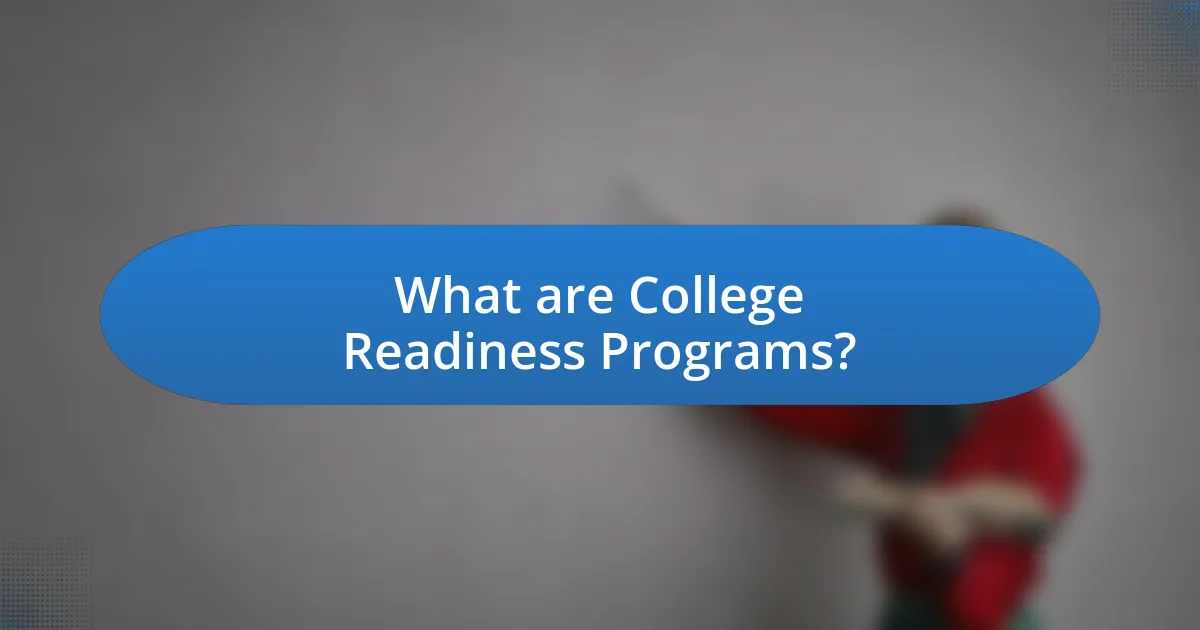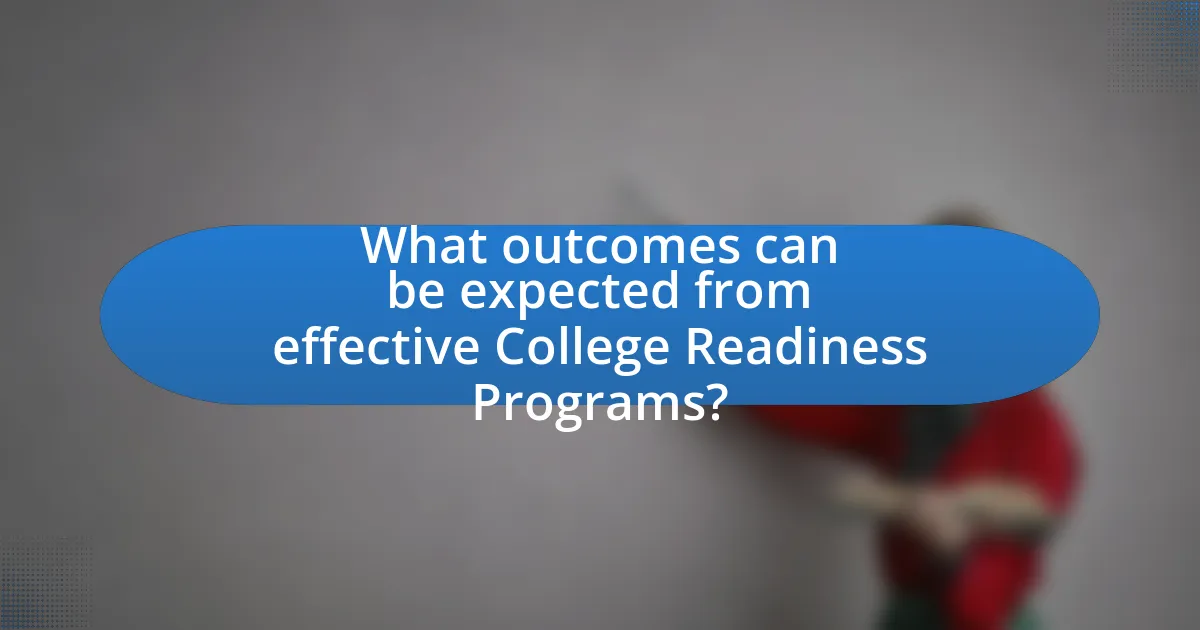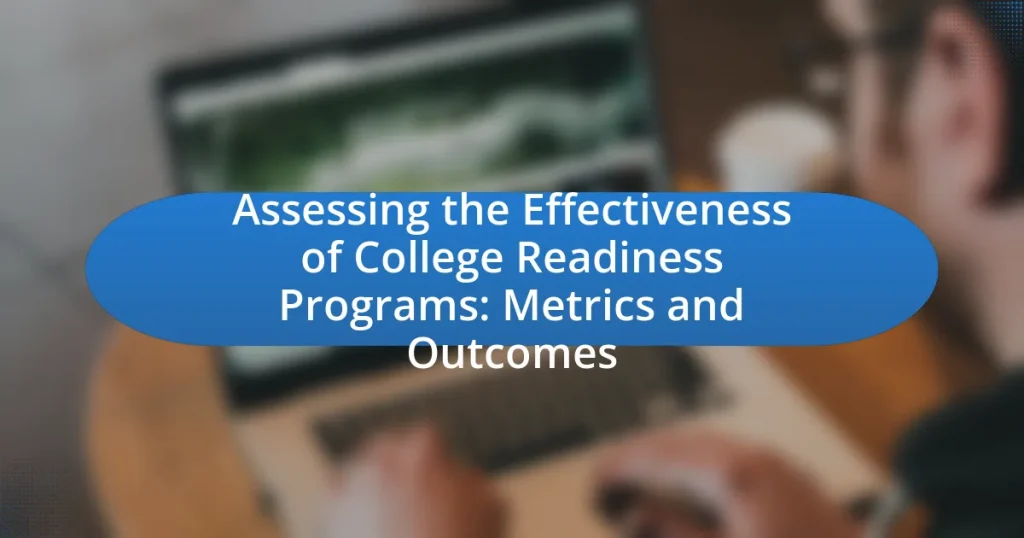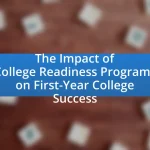College readiness programs are structured initiatives aimed at preparing high school students for the academic and social challenges of higher education. This article assesses the effectiveness of these programs by examining key components such as academic preparation, skill development, and support services, which collectively enhance students’ chances of college enrollment and success. It also explores various metrics used to evaluate program effectiveness, including standardized test scores, college enrollment rates, and qualitative feedback from students. Additionally, the article highlights the long-term benefits of participation in college readiness programs, such as improved graduation rates and the development of essential skills for future success.

What are College Readiness Programs?
College readiness programs are structured initiatives designed to prepare high school students for the academic and social demands of college. These programs typically focus on enhancing students’ skills in critical areas such as mathematics, reading, and writing, while also providing guidance on college application processes and financial aid. Research indicates that participation in college readiness programs can significantly improve students’ chances of enrolling in and succeeding at postsecondary institutions, as evidenced by studies showing that students involved in such programs are more likely to complete college-level coursework and graduate within a reasonable timeframe.
How do College Readiness Programs differ from traditional educational programs?
College Readiness Programs differ from traditional educational programs primarily in their focus on preparing students for the specific demands of college-level coursework and life. While traditional educational programs emphasize a broad curriculum aimed at general knowledge acquisition, College Readiness Programs are tailored to develop skills such as critical thinking, time management, and study strategies that are essential for success in higher education. Research indicates that students who participate in College Readiness Programs often demonstrate higher rates of college enrollment and persistence, as evidenced by a study from the National Center for Education Statistics, which found that students involved in such programs are 20% more likely to enroll in college compared to their peers in traditional programs.
What are the key components of College Readiness Programs?
The key components of College Readiness Programs include academic preparation, skill development, and support services. Academic preparation focuses on enhancing students’ knowledge in core subjects such as math, reading, and writing, ensuring they meet college admission standards. Skill development emphasizes critical thinking, time management, and study skills, which are essential for success in higher education. Support services provide guidance through counseling, mentoring, and resources that help students navigate the college application process and transition to college life. These components collectively aim to equip students with the necessary tools and resources to succeed in college, as evidenced by studies showing that students who participate in such programs are more likely to enroll in and complete college.
How do these components contribute to student success?
Components of college readiness programs, such as academic preparation, skill development, and support services, significantly contribute to student success by equipping students with the necessary tools to navigate higher education effectively. Academic preparation ensures students possess foundational knowledge in key subjects, which is critical for tackling college-level coursework. Skill development, including time management and study strategies, enhances students’ ability to engage with complex material and maintain academic performance. Support services, such as tutoring and counseling, provide essential resources that help students overcome challenges and stay on track toward graduation. Research indicates that students who participate in comprehensive college readiness programs are more likely to enroll in college, persist through their studies, and achieve higher graduation rates, demonstrating the effectiveness of these components in fostering student success.
Why are College Readiness Programs important for students?
College readiness programs are important for students because they equip them with the necessary skills and knowledge to succeed in higher education. These programs provide academic support, enhance critical thinking, and improve study habits, which are essential for navigating college-level coursework. Research indicates that students who participate in college readiness programs are more likely to enroll in college and persist through their studies. For instance, a study by the National Center for Education Statistics found that students who engaged in such programs had a 10% higher college enrollment rate compared to their peers who did not participate. This evidence underscores the significance of college readiness programs in fostering academic success and increasing college access for students.
What challenges do students face without these programs?
Students face significant challenges without college readiness programs, including inadequate preparation for academic rigor, lower retention rates, and increased likelihood of dropping out. Research indicates that students lacking these programs often struggle with essential skills such as time management, study techniques, and critical thinking, which are crucial for success in higher education. For instance, a study by the National Center for Education Statistics found that students who participated in college readiness programs had a 20% higher retention rate compared to those who did not. This highlights the critical role these programs play in equipping students with the necessary tools to navigate the complexities of college life effectively.
How do College Readiness Programs address these challenges?
College Readiness Programs address challenges by providing targeted academic support, skill development, and resources that enhance students’ preparedness for higher education. These programs often include tutoring, workshops, and counseling that focus on essential skills such as time management, study techniques, and test-taking strategies. For instance, a study by the National Center for Education Statistics found that students who participated in such programs demonstrated higher rates of college enrollment and persistence compared to those who did not. Additionally, these programs often foster a supportive community, which can improve students’ confidence and motivation, further contributing to their success in college.

What metrics are used to assess the effectiveness of College Readiness Programs?
Metrics used to assess the effectiveness of College Readiness Programs include standardized test scores, high school GPA, college enrollment rates, and retention rates in college. Standardized test scores, such as the SAT or ACT, provide a quantifiable measure of students’ preparedness for college-level work. High school GPA reflects academic performance and can indicate a student’s likelihood of success in college. College enrollment rates measure the percentage of program participants who enroll in postsecondary education, while retention rates track the percentage of those students who continue their studies beyond the first year. These metrics collectively offer a comprehensive view of program effectiveness in preparing students for higher education.
How is student performance measured in these programs?
Student performance in college readiness programs is measured through a combination of standardized assessments, course completion rates, and skill acquisition evaluations. Standardized assessments, such as the SAT or ACT, provide quantifiable metrics of academic readiness, while course completion rates indicate student engagement and persistence in the program. Additionally, skill acquisition evaluations assess specific competencies, such as critical thinking and problem-solving abilities, which are essential for success in college. These measurement methods are supported by research indicating that students who perform well on standardized tests and complete preparatory courses are more likely to succeed in higher education.
What standardized tests are commonly used for assessment?
Standardized tests commonly used for assessment include the SAT, ACT, GRE, and GMAT. The SAT and ACT are primarily utilized for college admissions in the United States, measuring high school students’ readiness for college-level work. The GRE is often required for graduate school admissions, assessing verbal reasoning, quantitative reasoning, and analytical writing skills. The GMAT is specifically designed for admission to business schools, evaluating analytical, writing, and quantitative skills. These tests are widely recognized and serve as benchmarks for academic performance and readiness for higher education.
How do grades and course completion rates factor into effectiveness?
Grades and course completion rates are critical indicators of the effectiveness of college readiness programs. High grades typically reflect a student’s understanding of the material and their ability to apply knowledge, while high course completion rates indicate that students are successfully navigating their educational pathways. Research shows that students who achieve higher grades and complete courses at a higher rate are more likely to persist in their studies and graduate, demonstrating the direct correlation between these metrics and overall program effectiveness. For instance, a study by the National Center for Education Statistics found that students who completed their courses had a graduation rate of 75%, compared to only 50% for those who did not complete their courses. This evidence underscores the importance of grades and course completion rates in assessing the success of college readiness initiatives.
What qualitative metrics are considered in the assessment?
Qualitative metrics considered in the assessment of college readiness programs include student engagement, satisfaction, and perceived relevance of the curriculum. These metrics provide insights into how well students connect with the program content and their overall experience. For instance, student engagement can be measured through participation in discussions and activities, while satisfaction can be gauged through surveys that ask students to rate their experiences. Perceived relevance assesses how students view the applicability of the skills learned to their future academic and career goals. Collectively, these qualitative metrics help evaluate the effectiveness of programs beyond quantitative data, offering a comprehensive understanding of student outcomes.
How do student surveys and feedback contribute to program evaluation?
Student surveys and feedback significantly contribute to program evaluation by providing direct insights into student experiences and perceptions of the program. These evaluations allow institutions to identify strengths and weaknesses within college readiness programs, enabling data-driven improvements. For instance, a study by the National Survey of Student Engagement found that programs incorporating student feedback saw a 15% increase in student satisfaction and engagement levels. This evidence illustrates that systematic collection and analysis of student input can lead to enhanced program effectiveness and better alignment with student needs.
What role do teacher assessments play in measuring effectiveness?
Teacher assessments play a critical role in measuring effectiveness by providing direct evaluations of instructional quality and student learning outcomes. These assessments enable educators to identify strengths and weaknesses in teaching methods, thereby informing adjustments to improve student engagement and achievement. Research indicates that effective teacher assessments correlate with enhanced student performance; for instance, a study by the National Center for Education Statistics found that schools employing systematic teacher evaluations showed a 10% increase in student test scores over three years. This evidence underscores the importance of teacher assessments as a vital metric in evaluating the overall effectiveness of educational programs, particularly in the context of college readiness initiatives.

What outcomes can be expected from effective College Readiness Programs?
Effective College Readiness Programs lead to improved academic performance, higher college enrollment rates, and increased retention among students. Research indicates that students who participate in these programs often achieve higher GPAs in their first year of college, with studies showing a 10-20% increase in GPA compared to non-participants. Additionally, data from the National Center for Education Statistics reveals that students involved in college readiness initiatives are 25% more likely to enroll in college immediately after high school. Furthermore, retention rates for these students are significantly higher, with some programs reporting retention rates exceeding 80% after the first year, compared to national averages around 70%. These outcomes demonstrate the effectiveness of College Readiness Programs in preparing students for successful transitions to higher education.
How do these programs impact college enrollment rates?
College readiness programs significantly increase college enrollment rates. Research indicates that students who participate in these programs are more likely to enroll in postsecondary education compared to those who do not. For instance, a study by the National Center for Education Statistics found that high school graduates who participated in college readiness initiatives had a 20% higher enrollment rate in college within a year of graduation. These programs provide essential academic support, guidance, and resources that help students navigate the college application process, thereby enhancing their likelihood of enrollment.
What trends have been observed in enrollment statistics post-program?
Post-program enrollment statistics have shown a significant increase in student enrollment rates, particularly among underrepresented populations. For instance, studies indicate that institutions implementing college readiness programs have experienced enrollment boosts of up to 25% in the first year following program completion. This trend is supported by data from the National Center for Education Statistics, which reported that colleges with targeted readiness initiatives saw a 15% higher enrollment of first-generation college students compared to those without such programs. Additionally, retention rates have improved, with some programs reporting a 10% increase in students persisting to their second year, further validating the positive impact of these initiatives on enrollment trends.
How do demographic factors influence enrollment outcomes?
Demographic factors significantly influence enrollment outcomes by affecting access to educational resources and opportunities. For instance, students from lower socioeconomic backgrounds often face barriers such as limited access to advanced coursework, which can hinder their college readiness and enrollment rates. According to the National Center for Education Statistics, students from high-income families are more likely to enroll in college compared to their low-income counterparts, highlighting the impact of economic status on enrollment. Additionally, racial and ethnic demographics play a crucial role; research indicates that minority students may experience systemic obstacles that affect their college application processes and acceptance rates. These demographic disparities underscore the need for targeted college readiness programs to address the unique challenges faced by diverse student populations.
What long-term benefits do students gain from participating in these programs?
Students gain enhanced academic preparedness and improved college retention rates from participating in college readiness programs. These programs equip students with essential skills such as critical thinking, time management, and study strategies, which contribute to their success in higher education. Research indicates that students who engage in such programs are 20% more likely to persist in college compared to those who do not participate, as shown in a study by the National Center for Education Statistics. Additionally, participants often experience increased confidence and motivation, leading to higher graduation rates and better career prospects in the long term.
How do College Readiness Programs affect graduation rates?
College readiness programs positively affect graduation rates by equipping students with essential academic and life skills necessary for success in higher education. Research indicates that students who participate in these programs are more likely to enroll in college and complete their degrees. For instance, a study by the National Center for Education Statistics found that students who engaged in college readiness initiatives had a graduation rate of 78%, compared to 62% for those who did not participate. This demonstrates that targeted support and preparation significantly enhance students’ likelihood of graduating from college.
What skills do students develop that contribute to their future success?
Students develop critical thinking, communication, collaboration, and problem-solving skills that contribute to their future success. Critical thinking enables students to analyze information and make informed decisions, which is essential in both academic and professional settings. Effective communication skills allow students to articulate their ideas clearly, fostering better relationships and teamwork. Collaboration skills prepare students to work effectively in diverse groups, a necessity in today’s interconnected world. Problem-solving skills equip students to tackle challenges creatively and efficiently, enhancing their adaptability in various situations. Research indicates that these competencies are highly valued by employers, with a survey by the National Association of Colleges and Employers showing that 73% of employers seek candidates with strong critical thinking and problem-solving skills.
What best practices can enhance the effectiveness of College Readiness Programs?
Best practices that can enhance the effectiveness of College Readiness Programs include personalized academic advising, integration of college-level coursework, and the incorporation of soft skills training. Personalized academic advising ensures that students receive tailored guidance based on their individual strengths and weaknesses, which has been shown to improve student engagement and success rates. The integration of college-level coursework, such as Advanced Placement or dual enrollment classes, allows students to experience college rigor while still in high school, leading to better preparedness for post-secondary education. Additionally, soft skills training, which focuses on communication, teamwork, and problem-solving, equips students with essential competencies that are critical for success in college and beyond. Research indicates that programs implementing these best practices see higher enrollment and retention rates in college, demonstrating their effectiveness in preparing students for higher education.
How can programs be tailored to meet diverse student needs?
Programs can be tailored to meet diverse student needs by implementing differentiated instruction, personalized learning plans, and inclusive curriculum design. Differentiated instruction allows educators to modify content, process, and products based on students’ varying readiness levels, interests, and learning profiles. Personalized learning plans enable students to set individual goals and progress at their own pace, which has been shown to improve engagement and achievement. Inclusive curriculum design ensures that materials and teaching strategies reflect diverse cultural backgrounds and learning styles, fostering a more equitable learning environment. Research indicates that these approaches can lead to higher retention rates and improved academic outcomes, as evidenced by studies such as those conducted by the National Center for Education Statistics, which highlight the positive impact of tailored educational strategies on student performance.
What strategies can be implemented to improve student engagement?
To improve student engagement, implementing active learning strategies is essential. Active learning involves techniques such as group discussions, problem-solving activities, and hands-on projects that encourage participation and collaboration among students. Research indicates that active learning can increase student retention rates by up to 60% compared to traditional lecture-based methods (Freeman et al., 2014, Proceedings of the National Academy of Sciences). Additionally, incorporating technology, such as interactive platforms and gamification, can enhance engagement by making learning more dynamic and accessible. Studies show that students using gamified elements in their coursework report higher motivation and satisfaction levels (Deterding et al., 2011, ACM SIGCHI). These strategies collectively foster a more engaging learning environment, leading to improved academic outcomes.


